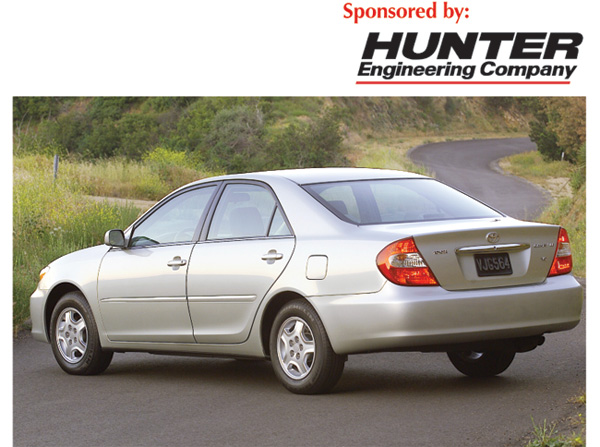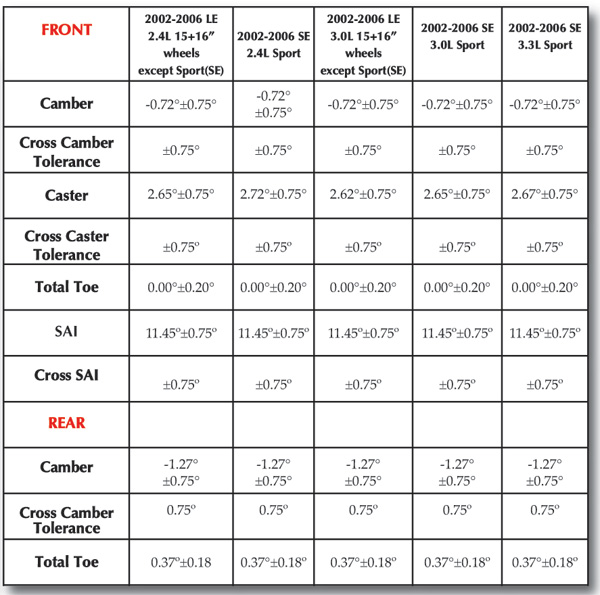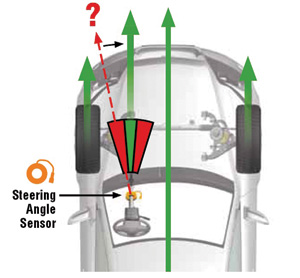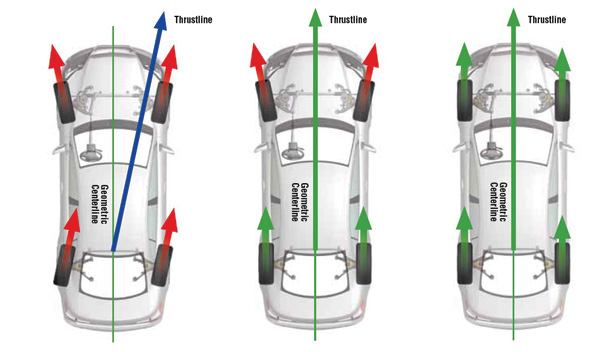
What makes this vehicle #1 in alignment circles is the fact the Camry is the highest ranked vehicle on the sales charts with an optional stability control system called Vehicle Stability Control (VSC) that requires a special procedure and scan tool to recalibrate the steering angle, deceleration and yaw rate sensors.
When you get a 2002-2006 Camry in your shop, it is important to find out if it is a four-cylinder or V6 model, and if it is a SE or LE model. Typically this information can be found on the rear trunk panel above the bumper in chrome letters.
To find out if the vehicle has the optional VSC system, light will illuminate on the dash when the vehicle is first started. 
Suspension
The suspension on the Camry is nothing special and has no real quirks. The only shocker is that the front caster is non-adjustable and there are no special kits or tools to alter the caster angle. If the caster is out of specification, chances are that the lower control arm has been damaged.
Toyota designed the control arm on the Camry to absorb and deform during impacts so the body and suspension cradle will not be damaged.
Replacement control arms are readily available for this vehicle. Pay attention to the included angle or SAI. This diagnostic angle can help you determine if the control arm or knuckle has been damaged.
The only significant TSBs listed for suspension system concerns noise coming from the upper strut mounts in the front and rear on 2002-2006 models.
The TSBs direct technicians to check the torque of the strut mount and bolts that hold the strut mount to the body. Similar TSBs direct technicians to install an updated mount or insulator between the body. Check your service information for the right information concerning the vehicle’s VIN before servicing.
Another area that has plagued the Camry is the steering shaft and noise. For some 2002-2003 models, TSB ST002-03 recommends using a syringe to apply dielectric grease between the intermediate shaft and grommet in the firewall if the driver reports a “low frequency” noise while turning. For some 2003-2006 models, T-SB-0296-08 advises to remove and lubricate the intermediate shaft if the driver experiences a clunk pop or knock type noise when turning.
Electronics
Some Camry models are equipped with an optional Vehicle Stability Control (VSC) system that require a scan tool and special procedure to perform a zero point calibration of the yaw rate, deceleration and steering angle sensor recalibrate the steering position/angle and yaw rate sensors after the vehicle has been aligned. Yes, it is possible to reset the system by jumping two pins in the diagnostic connector and disconnecting the battery. But, there is no way to confirm or document the calibration was properly performed.
The steering position sensor’s basic function is to monitor the driver’s steering inputs. This includes the angle of the steering wheel and/or the rate at which the driver is turning the wheel. The steering position sensor on the Camry is located behind the steering wheel and is a high-resolution sensor.
The VSC system relies on accurate steering input from the steering angle sensor to analyze a situation and apply appropriate measures to help direct the vehicle on the intended path. If the system if not calibrated after a toe adjustment, the system will not operate properly and may illuminate the VSC malfunction light after the driver has picked up their Camry.
The Toyota VSC system uses the information from the steering position sensor and compares the information to the yaw rate sensor to determine what the car is doing. A yaw rate sensor is a gyroscopic device that measures a vehicle’s angular velocity around its vertical axis. On the Camry, the yaw rate senor is located under the center console bolted to the floor pan and is inline with the centerline of the vehicle. The sensor measures difference between the vehicle’s centerline and vehicle actual movement direction, this is called slip angle.
When a vehicle is aligned and the toe in the front or rear is altered it changes the thrust angle of the vehicle. The thrust angle is directly connected with the slip angle and the measurements taken by the yaw position sensor. Even if you adjust only the rear toe, you are altering the thrust angle and the steering position sensor must be calibrated. Why? The rear toe adjustment brought the thrust angle and center line into specification, the steering position sensor information has changed and so to has the information from the yaw position sensor due to the change in the thrust angle and slip angle the yaw position sensor measures.
 If the error is large enough, it will disable the system and turn the system’s malfunction indicator light on to alert the driver. If the error is small, it will operate as normal until certain conditions occur like driving on freeway ramps and tight streets. Under these conditions, the computer might unnecessarily activate stability control system slowing the vehicle or even fail to respond with the right corrective action causing the vehicle to leave the road.
If the error is large enough, it will disable the system and turn the system’s malfunction indicator light on to alert the driver. If the error is small, it will operate as normal until certain conditions occur like driving on freeway ramps and tight streets. Under these conditions, the computer might unnecessarily activate stability control system slowing the vehicle or even fail to respond with the right corrective action causing the vehicle to leave the road.
Toyota recommends disconnecting the cable from the negative battery terminal for more than two seconds before starting the Yaw rate sensor and deceleration sensor recalibration procedure. This resets the steering angle sensor zero point. Before disconnecting the battery, make sure to write down the radio presets. Most scan and alignment tools that can interface with the vehicle will prompt you through the re-calibration procedure.
After you are done, you will also have to re-initialize all applicable systems available on the vehicle like power windows and sunroof. To re-initialize the windows, open the window and close the power window by holding the Auto UP knob ON. Continue to hold the Auto UP knob ON a minimum of one second after the power window completely closes. For the sunroof, press and hold the TILT UP switch until the roof glass tilts upward fully (the roof glass automatically tilts downward slightly after fully tilting upward).












